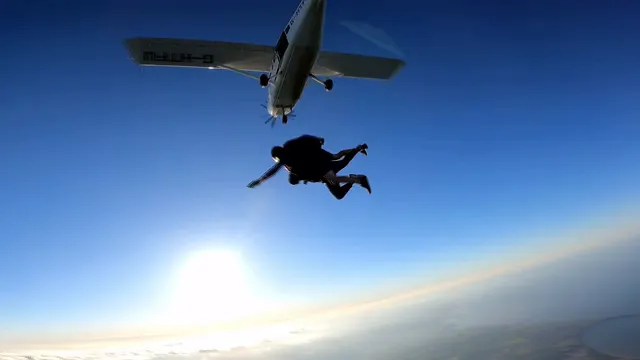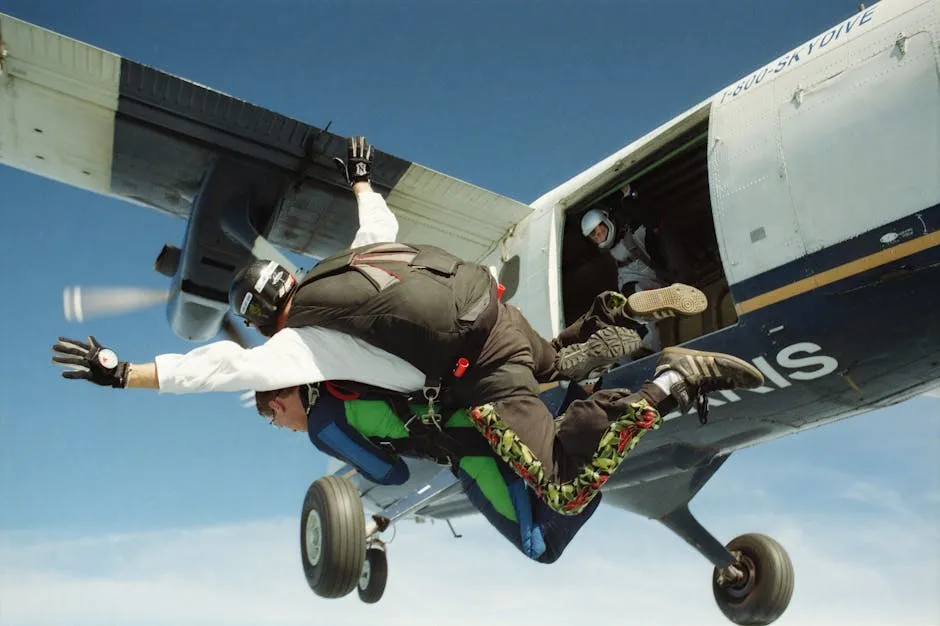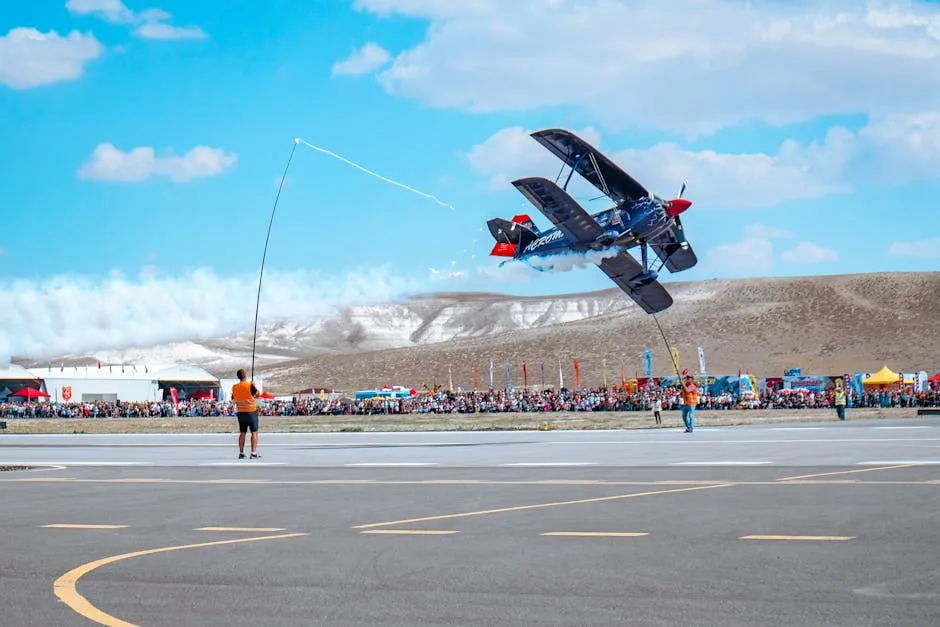Introduction
Skydiving is often seen as the ultimate thrill ride. Picture this: you step out of an airplane, a rush of adrenaline floods your veins, and for a few exhilarating moments, you defy gravity. But let’s face it—jumping out of a perfectly good airplane isn’t without its risks. Indeed, skydiving is an extreme sport, and with that title comes a certain level of danger.
Understanding the statistics surrounding skydiving deaths is crucial for anyone considering this leap into the unknown. The numbers tell a fascinating story, one that reveals both the allure and the risks of the sport. For potential jumpers, these statistics can provide some much-needed perspective. After all, knowledge is power, right?
Here’s some good news: over the years, fatalities in skydiving have declined significantly. Thanks to advancements in safety equipment and training, the sport has become safer than ever. In fact, the United States Parachute Association (USPA) reported only 10 civilian fatalities in 2023, the lowest number since record-keeping began in 1961. The continual evolution of technology, from automatic activation devices to modern parachute designs, has played a pivotal role in this downward trend.
This article aims to provide a thorough analysis of skydiving death statistics. We’ll dissect the data, highlight key trends, and ultimately arm you with the information you need to make informed decisions about skydiving. So, strap on your parachute and get ready—this journey through the statistics of skydiving deaths is about to take off!

Historical Context of Skydiving Safety
The Evolution of Skydiving
Skydiving has come a long way from its military roots. Initially used for tactical purposes during World War I, it has transformed into a popular civilian sport embraced by thrill-seekers worldwide. The transition began in earnest in the 1960s, when recreational skydiving took off, combining daring jumps with a sense of community.
Significant milestones mark this evolution. The introduction of tandem skydiving in the 1980s allowed first-timers to jump strapped to experienced instructors, significantly reducing the risk for beginners. Additionally, advancements like the three-ring release system and skydiving suits have dramatically improved safety.
As training techniques evolved, so did the emphasis on safety protocols. Today, aspiring skydivers undergo rigorous training, learning essential skills that keep them safe in the air. The cumulative effect of these developments is clear: the sport of skydiving has become markedly safer, with fatalities decreasing even as the number of jumps has increased.
In short, skydiving has transitioned from a risky military maneuver to an exhilarating sport, all while getting safer with every leap into the blue. Understanding this historical context is vital as we analyze the current statistics on skydiving deaths. It reminds us that while risks remain, the sport is thoughtfully organized to protect its participants.
Fatality Trends Over the Decades
Skydiving has seen a remarkable transformation in safety over the decades. In the 1960s, the sport was still in its infancy, marked by a staggering fatality rate. Between 1961 and 1969, the average fatalities were between 6 and 11.12 per 100,000 jumps. Fast forward to 2001, and the number of fatalities peaked at 35 in a single year, corresponding to the growing popularity of the sport. This period highlighted a need for better safety measures, which prompted significant advancements in training and equipment.
By 2023, the landscape changed dramatically, with only 10 civilian fatalities reported, a record low since statistics began. This decline can be attributed to various factors, including enhanced safety protocols, improved training methodologies, and the advent of modern parachuting technology. The current fatality rate stands at just 0.27 deaths per 100,000 jumps, showcasing a stark contrast to the early days of skydiving.
To illustrate this decline, consider these key years: In 1961, the sport faced 22 fatalities from approximately 19,000 jumps. In 2001, 35 fatalities occurred in a year when the number of jumps surged to over 2.7 million. Then, in 2023, the USPA documented only 10 fatalities amidst 3.65 million jumps. This dramatic decrease reflects the ongoing commitment to safety and the effectiveness of evolving practices within the skydiving community.

Current Skydiving Death Statistics
Overall Statistics
The present-day statistics paint a reassuring picture for potential skydivers. According to the United States Parachute Association (USPA), in 2023, there were 10 reported civilian fatalities among approximately 3.65 million skydives, marking a significant achievement for the sport’s safety record. To put this into perspective, this translates to a fatality rate of just 0.27 deaths per 100,000 jumps, reinforcing the notion that skydiving has become considerably safer over the years.
A deeper dive into the statistics reveals a consistent decline in fatalities over the last two decades. For example, in 2000, there were 35 fatalities amid 2.6 million jumps, resulting in a much higher fatality rate of 1.34 per 100,000 jumps. By 2010, the numbers improved, with 21 fatalities reported out of 3 million jumps, which lowered the fatality rate to 0.70 per 100,000 jumps. Fast forward to 2023, and we see the lowest fatality rate ever recorded.
When we analyze fatalities over the years from 2000 to 2023, a clear downward trend emerges. The numbers fluctuate yearly, but the general trajectory is undeniably positive. For instance, in 2022, there were 20 fatalities from 3.9 million jumps, leading to a rate of 0.51. In comparison, the fatality rates in earlier years, such as 2018 (0.39) and 2019 (0.45), further illustrate this gradual decline.
In conclusion, the current statistics underscore that while skydiving involves inherent risks, the sport has made significant strides in safety. The efforts of the skydiving community in embracing improved technology and training protocols have undeniably contributed to this positive trend. As the sport continues to evolve, potential jumpers can feel more confident than ever in the safety measures and practices that surround this thrilling adventure.

For a deeper understanding of the risks involved in skydiving, check out the skydiving fatality statistics.
Factors Contributing to Fatalities
Skydiving, while thrilling, carries its share of risks, leading to fatalities. Understanding the reasons behind these tragic incidents is key to improving safety. The primary causes can be categorized into two groups: equipment failure and human error. Surprisingly, most accidents stem from human error rather than faulty gear. Think of it like driving—most accidents happen not because of mechanical failure, but due to the driver’s choices.
Landing errors are a common issue. Many experienced jumpers underestimate the importance of proper landing techniques. This can lead to injuries or fatalities, especially when landing in tricky conditions. Canopy control also plays a significant role. Jumpers who misjudge their canopy’s performance or wind conditions may find themselves in perilous situations. Have you ever tried to parallel park a car with a blindfold on? It’s a bit like that, but with much higher stakes.
When comparing tandem and experienced jumps, fatality rates vary. Tandem skydiving, where novices jump with seasoned instructors, is statistically safer. The fatality rate for tandem jumps is approximately one in 500,000, while experienced jumpers face about one in 220,000. This stark difference highlights the safety net that tandem instructors provide, making it a preferred choice for first-time jumpers.
Specific incidents also reveal patterns. For instance, a significant number of fatalities occur during high-performance landings, where jumpers push their limits. The allure of speed can lead to risky maneuvers that, while exhilarating, can result in tragic outcomes. Additionally, in recent years, reports indicate an increase in fatalities attributed to lower altitude landings, often linked to inexperience or overconfidence. As the saying goes, “Pride comes before a fall”—and in skydiving, that fall can be fatal.
Training plays a crucial role in mitigating these risks. Comprehensive education on equipment usage, landing techniques, and canopy control can dramatically reduce the likelihood of accidents. In essence, the more informed the jumper, the safer the experience. The skydiving community continues to emphasize safety, and with ongoing training and awareness, the goal is to keep the sport thrilling yet safe for everyone involved.

Training and Safety Protocols
Skydiving is not just a leap of faith; it’s a calculated plunge into adventure. To enjoy this thrilling experience safely, comprehensive training is essential for both tandem and licensed skydivers. So, what does that training entail?
For tandem skydiving, the process is straightforward. First-time jumpers are securely harnessed to experienced instructors. These instructors have undergone rigorous training, often requiring at least 500 jumps and specific certifications. They’re like the wise old owls of the sky, guiding novices through their exhilarating descent. Before the jump, students learn about equipment checks, body positions, and emergency protocols. This preparation makes the experience both safe and enjoyable!
Licensed skydivers, on the other hand, embark on a more extensive training journey. They start with Accelerated Freefall (AFF) courses, which require a minimum of 25 jumps to earn a license. This training includes ground school, where they learn about parachute systems, safety checks, and emergency procedures. Once they graduate to solo jumps, their training continues with advanced canopy control and landing techniques. It’s like getting your driver’s license, but with a much cooler view!
Safety culture within the skydiving community is paramount. Skydivers frequently emphasize self-discipline, accountability, and mutual respect. Jumpers are encouraged to participate in safety seminars, where they discuss incidents, share experiences, and learn from one another. This collaborative approach fosters a strong safety net that enhances the overall experience for everyone involved.
Instructor experience and the reputation of drop zones are also critical components of skydiving safety. Reputable drop zones ensure that all instructors are properly rated and maintain high standards of safety. They inspect equipment regularly, and their commitment to safety protocols helps mitigate risks. Think of it as choosing a restaurant; you wouldn’t want to eat at a place known for food poisoning!
In conclusion, rigorous training and a robust safety culture help minimize risks in skydiving. By prioritizing instructor expertise and ensuring drop zones uphold safety standards, the skydiving community continues to make leaps toward a safer experience for everyone involved.

Comparative Analysis: Skydiving vs. Other Activities
Risk Assessment
When comparing risks, skydiving may seem daunting, but the numbers tell a different story. The fatality rate for skydiving is around 0.27 deaths per 100,000 jumps in 2023. That’s like winning the lottery of life! In contrast, the odds of dying in a car accident are approximately 1 in 93. Yes, you read that right—driving is statistically riskier than jumping out of a plane!
To better understand these risks, let’s introduce the concept of micromorts. A micromort represents a one-in-a-million chance of death from an activity. Jumping from full altitude in a properly managed skydiving scenario incurs about eight micromorts. For perspective, driving 1,800 miles presents a similar risk. Surprised? You should be!
Skydiving’s safety record shines even brighter when juxtaposed with other sports. The odds of fatalities in activities like scuba diving or rock climbing are significantly higher. So, while skydiving may seem like an extreme sport, it’s actually safer than many people believe.
Ultimately, understanding these statistics allows potential jumpers to make informed decisions. Skydiving is thrilling, but it’s also a calculated risk—one that many choose to take, knowing that the odds are in their favor. So, whether you’re considering your first jump or you’re a seasoned pro, remember that the sky is calling, and the statistics are on your side!

Public Perception of Skydiving Safety
Many folks think skydiving is a death wish. But hold on! That perception often stems from a few key misconceptions. One common belief is that skydiving accidents are frequent and lethal. In reality, the numbers tell a different story. According to the United States Parachute Association (USPA), the fatality rate is just 0.27 deaths per 100,000 jumps in 2023. This statistic is lower than many everyday activities, like driving a car!
A lot of the fear surrounding skydiving comes from media portrayals. Movies and TV shows often dramatize accidents, showing the worst-case scenarios. While these depictions can be thrilling, they don’t reflect the reality of modern skydiving. Safety measures have significantly evolved over the years. Jumpers now use advanced equipment, like skydiving helmets, which enhance safety.
Moreover, tandem skydiving is statistically safer. Newbies jump with experienced instructors, greatly reducing risks. The fatality rate for tandem jumps is about one in 500,000. This safety net attracts many who would otherwise shy away from the sport.
So, is skydiving as dangerous as it seems? Not really! With proper training and safety protocols, it’s safer than people often think. Understanding these facts can help shift public perception, allowing potential jumpers to make informed choices. Knowledge is key to embracing the thrill of freefalling!

Conclusion
In summary, while skydiving does carry inherent risks, the statistics reveal a different story. The sport has seen a remarkable decline in fatalities over the decades, thanks to advancements in equipment and training. With only 10 civilian fatalities reported in 2023, the fatality rate stands at an all-time low of 0.27 deaths per 100,000 jumps. This data underscores a significant improvement in safety, making skydiving a far less dangerous activity than many perceive.
It’s crucial to remember that most skydiving accidents stem from human error rather than equipment failure. This highlights the importance of proper training and adherence to safety protocols. Tandem skydiving, in particular, provides a safer option for first-time jumpers, pairing them with experienced instructors who manage the jump’s complexities.
For anyone considering skydiving, take the time to research and understand the risks involved. Familiarize yourself with the safety measures in place at reputable drop zones. It’s essential to choose a facility that prioritizes safety and has a solid track record. The skydiving community is dedicated to promoting safe practices, and aspiring jumpers should feel empowered to ask questions and seek information.
Ultimately, while skydiving is an extreme sport, it can be enjoyed safely. By making informed decisions based on the statistics and understanding the advancements in safety protocols, individuals can embrace the thrill of skydiving without undue fear. Remember, the sky is calling—are you ready to answer?

How many people die from skydiving each year?
According to the USPA, in 2023, there were only 10 reported civilian fatalities in the U.S. This marks a record low, with over 3.65 million jumps made in that year. Historically, the fatality rate has decreased significantly over the decades, showcasing improved safety in the sport.
Is skydiving safer than driving?
Yes! The odds of dying in a skydiving accident are much lower than in a car accident. The fatality rate for skydiving is approximately 0.27 per 100,000 jumps, while the odds of dying in a car crash are about 1 in 93. This stark comparison illustrates that driving is statistically riskier than skydiving.
What are the main causes of skydiving fatalities?
The primary causes of skydiving fatalities include human error, such as improper landing techniques and canopy control issues. Equipment failure is less common. Most accidents occur due to experienced jumpers pushing their limits, rather than faulty gear.
How can I ensure a safe skydiving experience?
To ensure safety, choose a reputable drop zone with qualified instructors. Research their safety record and equipment maintenance practices. Familiarize yourself with safety protocols, including emergency procedures and landing techniques. Following these tips can greatly enhance your skydiving experience.
What advancements have improved skydiving safety over the years?
Skydiving safety has improved due to advanced equipment, such as automatic activation devices (AADs) and modern parachute designs. Additionally, rigorous training programs for instructors and jumpers have enhanced overall safety protocols. These advancements contribute to the sport’s declining fatality rates and increasing safety standards.
Please let us know what you think about our content by leaving a comment down below!
Thank you for reading till here 🙂
All images from Pexels




